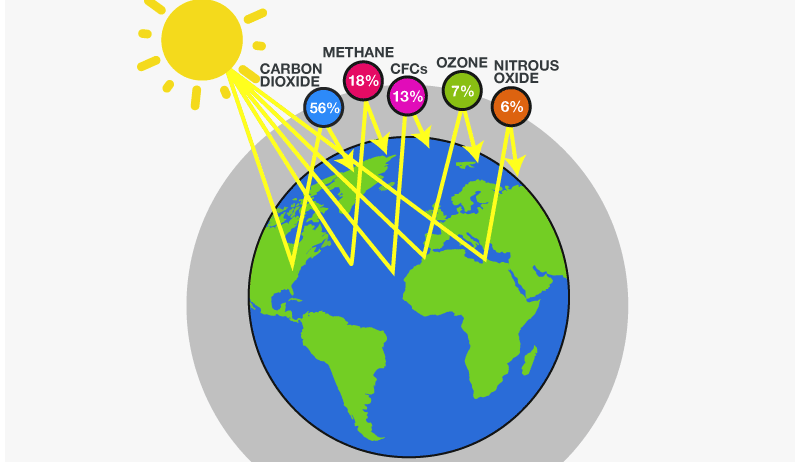The thermodynamic ballet of our planet, a delicate balance between the energy received from the sun and the energy radiated back to space, is intricately woven into the phenomenon known as the greenhouse effect. This natural occurrence supports life on Earth, yet it stands on the precipice of change due to human intervention. To demystify this scientific concept and understand its implications, let us embark on a cerebral journey through the atmospheric layers.
In its essence, the greenhouse effect is comparable to a cozy blanket enveloping our planet. It regulates temperature, ensuring that the Earth’s surface maintains a hospitable climate. But how does this magnificent mechanism operate? With a blend of sunlight, gases, and physical principles, the greenhouse effect exemplifies a fascinating interplay between solar radiation and atmospheric chemistry.
Sunlight, a celestial gift, reaches Earth predominantly in the form of visible light. A portion of this solar energy is absorbed by Earth’s surface, warming it. However, as the surface temperature increases, the Earth emits energy back into the atmosphere in the form of infrared radiation. This is where greenhouse gases step into the spotlight, reacting with this emitted energy and preventing it from escaping into outer space.
The foremost players in this ecological theater include carbon dioxide (CO2), methane (CH4), nitrous oxide (N2O), and water vapor (H2O). While these gases are present in minute quantities, their impact on our climate is profound. Carbon dioxide, for instance, has garnered notoriety as a significant contributor to climate change due to its long atmospheric lifespan and its association with fossil fuel combustion. Methane, although it exists in smaller quantities, is approximately 25 times more effective than CO2 at trapping heat over a 100-year period, making it a potent player in the greenhouse gas arena.
Moving beyond the basic mechanics, the greenhouse effect’s implications enter a realm of urgency that demands our attention. Long-term accumulation of greenhouse gases has led to an alarming uptick in global temperatures, which in turn affects weather patterns, sea levels, and ecosystems. A deeper understanding of these changes can spark curiosity and concern, motivating action and dialogue surrounding climate solutions.
To illustrate the potential consequences of an overheated planet, we must first comprehend the concept of climate feedback loops. These processes occur when initial changes trigger further effects, thereby exacerbating the problem at hand. For example, as the Arctic ice melts due to rising temperatures, the planet loses a reflective surface, resulting in darker ocean water that absorbs more solar radiation. This feedback amplifies warming and accelerates the cycle of climate change.
Visualizing a world where the greenhouse effect spirals into catastrophe serves as a stark reminder of our precarious position. Temperatures rise, influencing severe weather events such as hurricanes, droughts, and floods. Biodiversity faces rampant threats as species struggle to adapt or migrate, leading to potential extinction for countless organisms. Our oceans, too, bear the brunt of this turmoil—as temperatures escalate, marine ecosystems face coral bleaching and increased acidity due to dissolved CO2.
Understanding the greenhouse effect emphasizes our responsibility as stewards of the planet. With knowledge comes power—the power to invoke systemic change, innovate sustainable technologies, and advocate for policies aimed at curtailing greenhouse gas emissions. Transitioning to renewable energy sources such as solar and wind, enhancing energy efficiency, and promoting sustainable land use practices are pivotal steps we must embrace to foster resilience against climate change.
Shifting our perspective from passive consumers to active participants can lead us to a sustainable equilibrium in our relationship with the Earth. The intricate science of the greenhouse effect opens the door to myriad possibilities for engagement in the fight against climate change. Every effort counts, from individual actions like reducing energy consumption and embracing a plant-based diet to collective initiatives that influence broader policy decisions.
In conclusion, the greenhouse effect occupies a crucial juncture in the narrative of our planet’s future. While it is an essential mechanism for life, the escalation of greenhouse gases presents a pressing challenge requiring immediate attention. By fostering awareness and embracing proactive measures, we can shift the trajectory of climate change and safeguard the delicate balance of our environment. The science behind greenhouse gases is not just an esoteric subject; it is a clarion call for a united response to a shared crisis.
Let us contemplate the future we desire and the steps necessary to achieve it. The greenhouse effect is an invitation to transform our curiosity into action, inspiring responsible stewardship of our planet.







